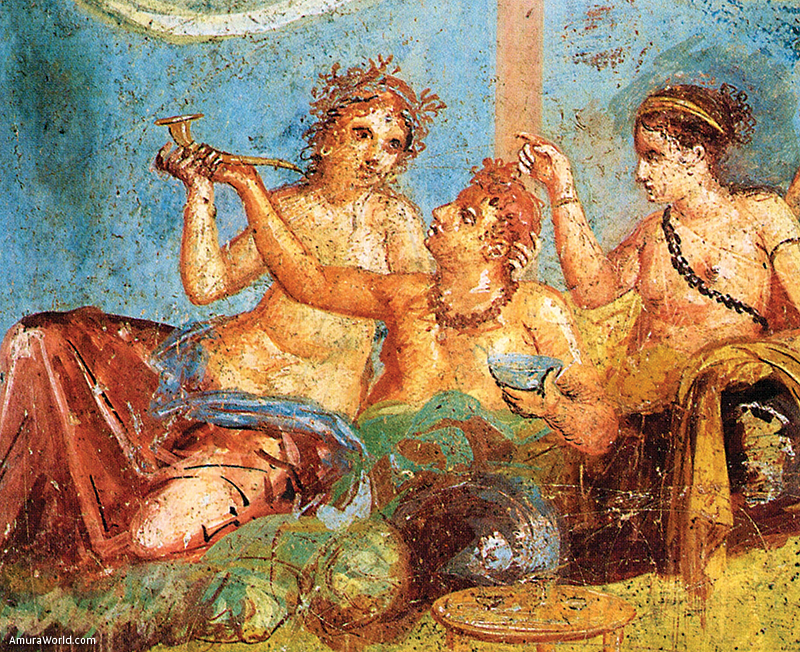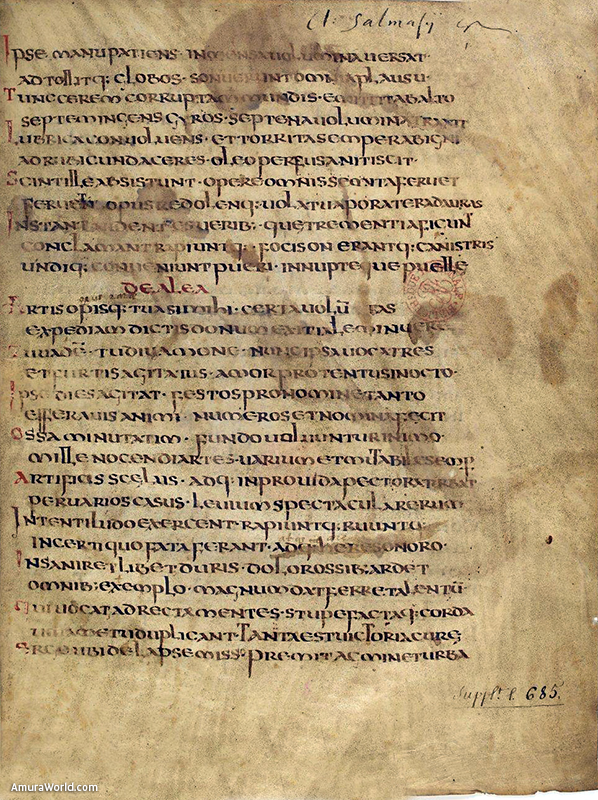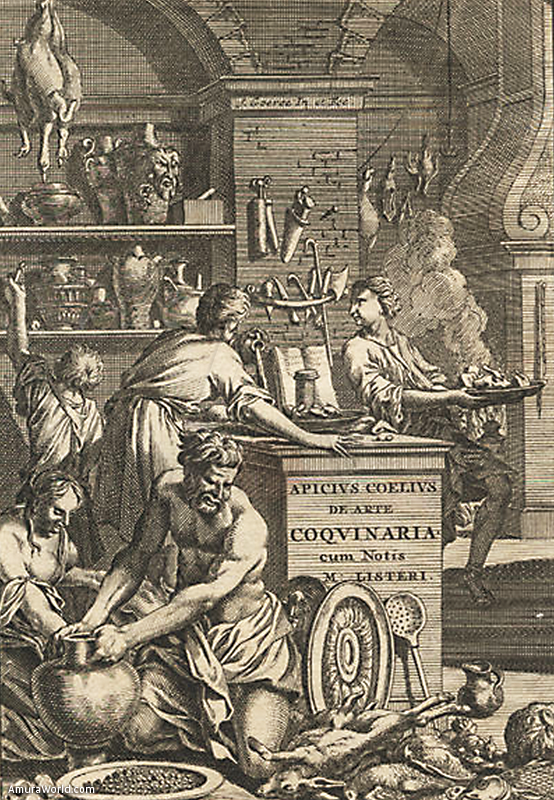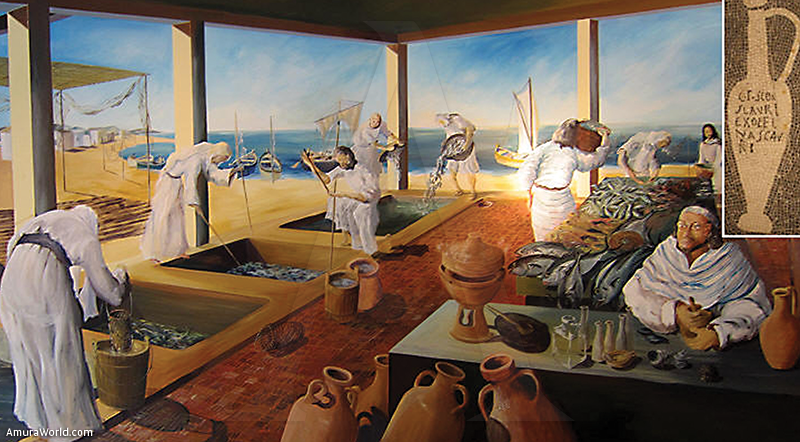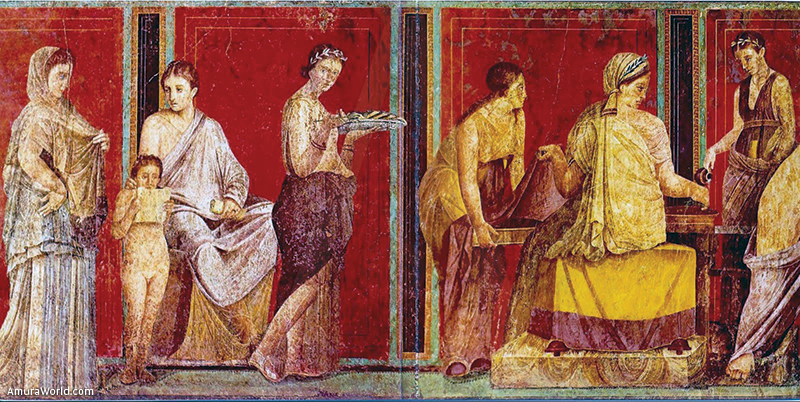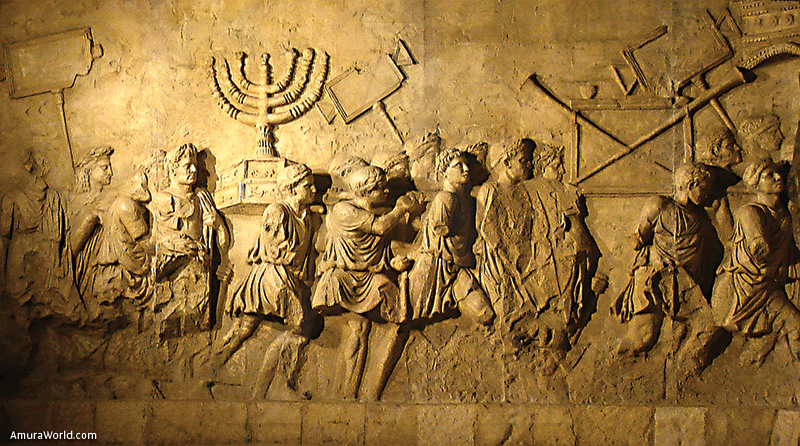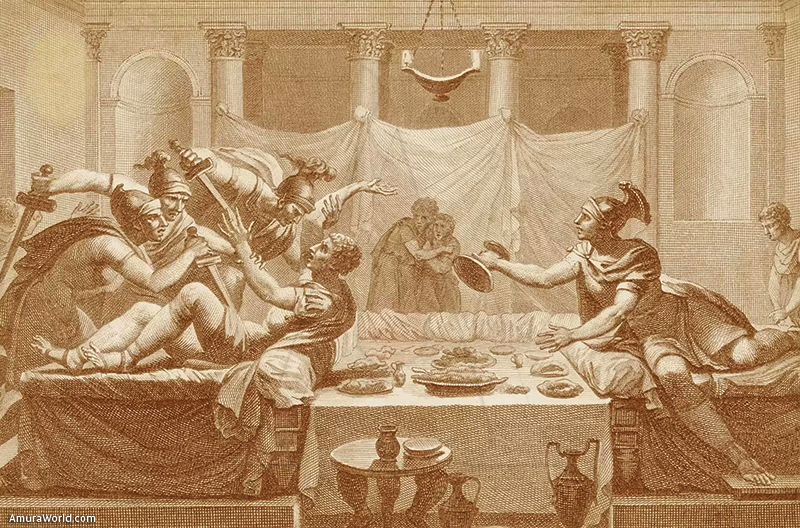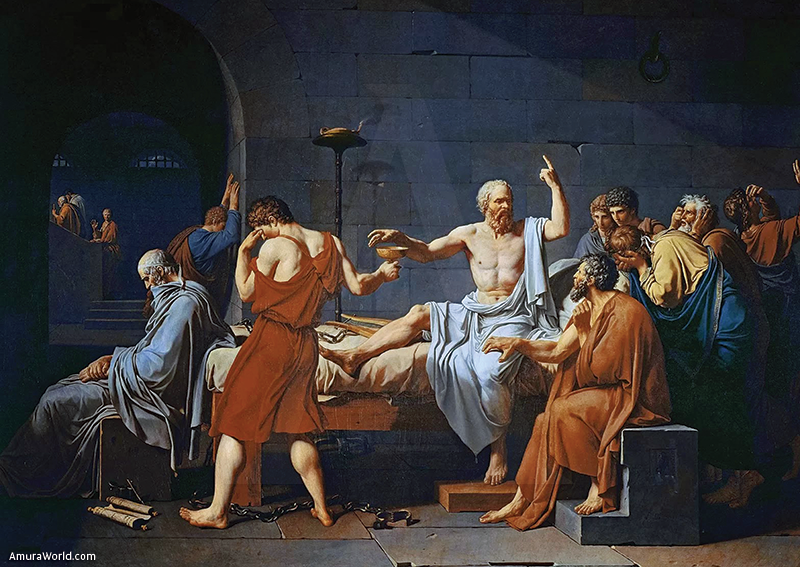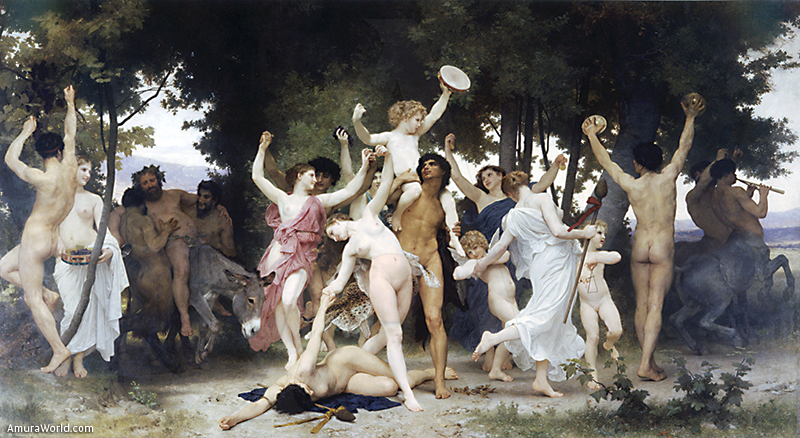The art of eating in the Greco-Roman times Ancient World
The ancient world, from Mesopotamia, Egypt, Greece until the Roman times, experimented a large period of perfectionnement, formation and even feedback amongst civilizations and people regarding gastronomy. This constant perfection and mutual in flow was accentuated considerably amongst the villages of the Mediterranean orbe, which flourished by uniting cultures that experimented a larger political, economic and social peak that generated a process of mutual culturalization and a transference of styles, fashions and inflows of political, religious and social character. This, proportioned a fascinating thread at a culinary level, which facilitated the bases for learning with new techniques, products and their perfection.
This social and cultural synergy, sometimes favored by pacts or alliances which is the product of an expansionist policy of some villages in benefit of others, led the way to not only exportation and importation but also of conservancy techniques, of transformation and consumption of food. This way, through the Mediterranean, they began to confection certain common traces of gastronomy in the ancient world, that currently create the origin of the well known and praised Mediterranean diet.
The ancient culinary treaties, in their compilation and edition, didn’t pass from a mere complication of indication and writings that are directed toward specialists in the subject, reason why at first glance, they may seem extremely vague and have a lack of content or technique. Thing is, the specialization of culinary professionals and gastronomy sybarites was so specific, that one of the main cards was not to reveal specifically all the steps for the elaboration of a dish. To the Greeks, amongst everything, we owe most of the compilation, assimilation and re elaboration for most treaties and culinary knowledge of the ancient world, since due to the fact that they were the center point of the mediterranean in a social, cultural and aesthetic way, they played the part of a vehicle for ideas, knowledge and innovation, setting the bases for occidental gastronomy.
In Ancient Greece, certain foods had a basic character (wheat) which involved a complex grasp rather the vine of grapes (wine) and olive (oil), were considered a gift from the gods -of divine origin- and only could be consumed in commemoratory occasions, something exclusively reserved for the elite closer to the image and attributes that irradiate the human greek gods. Later, their consumption became popular and in several occasions in literary sources a consumption of cereals in cakes and oat meal is mentioned. The vegetables, milk and restricted purchase of meat and fish as products of luxury due to the difficulty of their access by a major part of the population. It is interesting to stand out the authority of the Greek polis, which was concentrated in the alimentation of local markets, generating authentic authorities of production.
Despite the exclusive and divine character of some foods previously mentioned (wheat, wine and olive oil) the Greek philosophy understood frugality as a virtue, reason why in Hellenic continental cities like Esparta, Athens or Corinto, cuisine lacked of prestige and interest.
This way of thinking widely had a contrast with the tastes and tendencies toward the table being made in Greek colonies like the South of Italy and Sicily, in the Greek sleeve. These colonies, powerful and enriched by the commercial traffic of the Mediterranean, counted with the elite that reflected opulence in their richness and power in their banquets. Amongst them we can quote Siracuse, Selinune (whose coin was characterized by featuring a leave of parsley, basic ingredient in Mediterranean cuisine) or Sybaris, were the word “sybarite” comes from, word used to name its inhabitants. In these cities, in which accumulated richness blossomed and the Oriental exchange, is when the most refined Greek cuisine began to be practiced, with influences and techniques from Egypt and the Palestine-Syria coast.
Cities located in Anatolia also contributed by receiving oriental products. Once this took place, the figure of the cook begins to be valued once again. Here is where the concept of gastronomy was born, coming from the word “gaster” (stomach) and “nomos” (law, government, order). This concept is imposed in the ancient world and take force as the conception of gastronomy, an ordained treaty with norms and knowledge regulated by written work and orally transmitted. It is once more socially valued and the gourmet concept is born, from the gastronomer, the professional cook. One example would be the “Opsartiká”, famous and acknowledged professional cuisine treaties, such as Epeneto or Miteco.
From the Greek, the Romans pick up the “convivium” from the concept of“symposium”. In the “symposium”, The Greeks perform socializing in a sacralization of a group who in occasions enjoyed food and beverages together. It consisted of a normal ritual where conversation was unpredictable and the communion of spiritual, philosophical and other kinds of conversation were touched. In Greece, the banquet was celebrated always with a motive of dinner, the “deîpnon”, when the day ended and tasks or daily occupations that ended with nightfall. Right after dinner, the “symposium” began, in which the consumption of wine was ritualized, gift of from the gods, making civilized use of it, mixing it with water so drunkenness would not suddenly interrupt the conversation and more amicable and interesting subject could be spoken of.
Rome had a similar role, to compile and reinterpret all the techniques, duties, knowledge and know how gastronomics of the ancient world. Incorporating them to their culinary corpus at measure they conquered new territories, generating a cultural gastronomic knowledge without precedent until then. In a parallel manner, Rome used the Greek heritage of agricultural techniques, recollection process, transformation of prime materials and related techniques with kettle, fishing and poultry.
All of this is captured in treaties and works of literature such as Of Agriculture (Cato) Of Rustic (Colulmela) or Naturalis Historia (Plinium the Old).
The Empire, the great impulsor of these techniques, opened its immense channels of internal communication and made a more dynamic circulation, exportation and importation of food production, generating a powerful and thriving economy, in which commerce revealed a more lucrative activity, on which the roman governors rapidly made fortunes. The wine industry stood out, along with grain and exotic product of the orient.
To the markets of Rome, several Greek and Lusitan wines arrived, oils from Baltica (currently Andalucia), and meat products from the Galias, cereals from Northern Africa and fruits and spices from Orient; melons, plums and watermelons amongst others. Spices arrived massively from terrestrial and maritime routes which connected the empire to the coast of Syria and Palestine, Anatolia, Persia and Egypt. In the Roman kitchen, the use of pepper, mustard, cinnamon, thyme, oregano, basil, saffron laserpicio and seseli were rather frequent.
On the other hand, the commerce and production of “garum” existed, a sauce obtained by a process of the seasoning of fish, salt and aromatic herbs. Fundamentally used in fish with abundant fat like sardines, tuna and mackerel, this last one gave a great quality. Garum converted into an exclusive and indispensable product in the tables of the most reputed Roman tables, it was a common dressing with a great quantity of dishes due to its great saline qualities and excellent capacity of conservation. It production was mainly centered in the salines of South Hispania, closely linked to the transit of tuna from the strait of Gibraltar.
It is important to point out, that during the Republican era, Roma was influenced by customs and morals that praised social moderation, laws (leges sumptuary) and senate which put a stop to excess and ostentatious created by the governance. Further on, during the Imperial period, the refinement and luxury, along with the influence of Magna Greece which Began penetrating into the empire and ended up imposing, converting into a reflection of power and opulence of the noble classes. Because of the Greek and Oriental tendencies, the Roman governors would eat reclined; in their mansions several rooms called “triclinium” could be found for that particular use, equipped with reclinatories or “U” shaped based around central tables where food was served and wine was drank mixed with water, a custom inherited from the Greeks.
Among the popular classes the frequent consumption of this mix of almost exclusive character, the “pus” or “pullmentum”, a staple of the time, which consisted of a gruel to the lower classes often accompanied with something of timely manner meat, nuts, eggs or vegetables. If we add the fact that the kitchens were dependencies that used to correspond almost exclusively to the houses of the patricians, we can understand what was common among the populace; the use and consumption of food in the “thermopolium”: true fast food establishments (islands), which also prepared meals for consumption on the street or in homes, inside the residence of the masses cooking units did not exist. It was common to have lunch (prandimun) in a frugal character, since dinner was the most copious meal of the day.
Generally, except for the lower classes who ate the pullmentum once a day, the Romans carried out three meals a day: The ientaculum, at sunrise, which consisted of porridge or leftover food from the previous day with nuts, and soaked in milk or wine. By mid-morning, around noon, the prandium took place, a light lunch (consisting of wine, vegetables, fish and meats) usually away from home in the tabernae or thermopolium, and finally the Lord’s Supper, the copious meal of the day, it usually happened at about six or seven o’clock. Dinner was structured in different service courses (mensae), called this way because they were mounted on tables or boards that are served and completely withdrew in orderly succession.
Dinner enjoyed a high social character as the Greek symposium. This feast or convivium began with Augustus or gustatio consisting of being accompanied by light snacks and wine fermented with honey (mulsum), ideal to stimulate appetite. Then they would serve wine mixed with water and the feast continued with the mensa, made up of foods like iscias (meatballs), based creams, vegetables, fish and light meats. The main courses were encompassed and heavier around the Caput Mensa, seasoned with garum, such as “chicken frontoniano” extremely spicy, or pork, knuckle oats and garum sauce. Desserts and mulsum was the main focus on the second mensa, among whom were famous donuts, toast and dates stuffed with nuts, sweetened with honey and spices in order to intensify the sweetness of honey on the palate.
Then the comissatio occurred, a special celebration is along with dinner, which took place at a long desk. Diners are put on head wreaths, ivy, laurel, since some people thought that the smell of these plants neutralizes the effects of wine. Rex was appointed a convivium (master of ceremonies ) or arbiter of bibendis, which was usually the host or a prudent person, as he had to play a delicate role: the person should be
an expert in banquets, could not stop asking for wine, but nor remain sober, because it was uncomfortable for the other participants who could not authorize dishonest facts, but neither could limit the pleasures, he had to know the resistance of the guests to wine and mix with water according to the drunken state of diner; should encourage drinking and restrict some desire for others, so that everyone was in the same mood and intoxication.
In the convivium wine libations were made in honor of the gods, the homeland and the Emperor, and whenever the Rex drank it was provided to the health of any guest, absentees and, especially, friends. When the guest said the name of his beloved, he or she had to drink as many glasses as letters his name had. Especially beloved by the Romans were the condita or artificial wines, complex wines that were undergoing second fermentation maceration or (as the mulsum) with rose petals, violets or spices like cinnamon and herbs: parsley or myrtle.
Archeogastronomy: science that studies and reproduces luxury products of the Roman world.
The Interest of knowledge in gastronomy, diet, customs, rituals from the ancient world and the latest archaeological findings have allowed researchers to discover how and where they were made, what ingredients they had, why and when to consume some of the most exclusive products of ancient Roman tables, like wine or garum.
The ancient Roman surveyors treaties, Columella and Palladius, and best known culinary recipes of the Roman world , Re Coquinaria of Marcus Apicius, have been the basis for launching a research project on an experimental stage which helped a interdisciplinary team of archaeologists and specialized winemakers, held in Seville (Spain) by Dinamo Culture S. L. that has resulted in “Baetica”, a line of wines produced with the same Roman techniques and natural produce which is distributed exclusively by outlets and specialty channels. Reproduced wines that reached more fame and recognition in the finest banquet tables: the mulsum, wine roses, cinnamon and violets, appreciated for their taste, aroma and its complex system of production. Similarly, in Cadiz, a conserved residue in the vessels of a “tabernae” in Pompeii has allowed to reproduce garum two thousand years after a team of archaeologists, chemists and cooks from the Universities of Seville and Cadiz could analyze it. One of the gourmet products of the Romans, garum, a sauce produced from tuna and sea salt from the Bay of Cadiz, which will start marketing in Europe under the trademark “Flower Garum” to be in stores starting from the fall of 2013.
Text: Manuel León Béjar. Director COTIDIANA VITAE. Centro Temático Vida Cotidiana en Roma ± Photo: DEG / ALCAZABA / wps / romeart / BP / esacad / WPD



